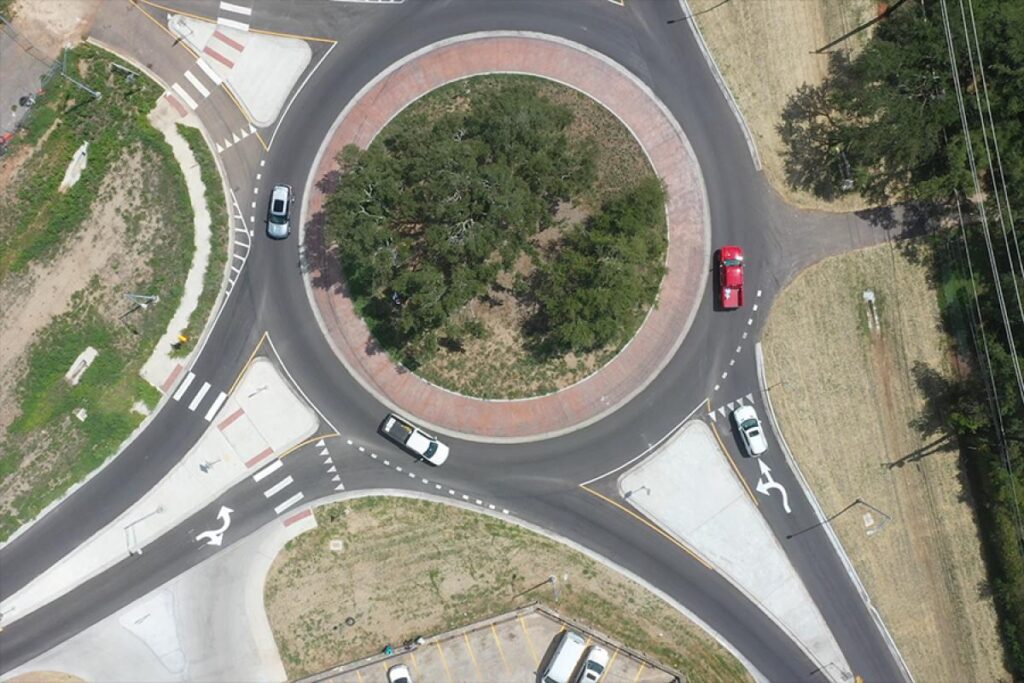Photo courtesy of TxDOT
TxDOT is looking to build more roundabout intersections to increase safety on Texas roads.
There are approximately 500 across the state and more are coming. Instead of traffic signals, roundabouts allow traffic to circulate (literally — counterclockwise) using only yield signs.
The Federal Highway Administration calls them a “proven safety countermeasure” because they substantially reduce crashes that result in serious injuries or death. According to a National Academy of Sciences study, roundabouts lead to a more than 90 percent reduction in fatalities, 76 percent reduction in injuries, 35 percent reduction in all crashes, and the slower speeds at roundabouts are also usually safer for pedestrians.
TxDOT Deputy Executive Director Brandye Hendrickson is the executive sponsor of a new roundabout task force at TxDOT and supported the creation of a new position to help the department understand and implement more so Texas can realize their benefits.
“Elevating our roundabouts culture and competency is going to be helpful to helping advance more projects and getting them built,” Hendrickson said.
From 2017-2019, Hendrickson served as acting administrator of the Federal Highway Administration (FHWA). During that term, she helped found National Roundabouts Week, which provides a time every year for organizations across the country to promote roundabouts. In 2023, National #RoundaboutsWeek is Sept. 18 to 22.
“There was a lot of enthusiasm for roundabouts and other alternative intersection designs across the country and thought we should have a campaign that would bring awareness to these great safety benefits,” Hendrickson said.
How do they lead to an overwhelming reduction in fatal and severe injury crashes? They essentially eliminate the most dangerous types of intersection crashes — the T-bone collision. They also lower speeds at the intersection to just 15 to 30 mph, so when crashes do happen, they are less severe.
Hendrickson said roundabouts are “a way of life” where she comes from in Indiana, where she saw firsthand what roundabouts can provide for drivers.
“Getting the chance to drive roundabouts in the communities where I live and the communities I serve really opened my eyes to the safety impacts and benefits that come along with innovative intersections,” Hendrickson said.
Roundabouts also save money in the long run and provide resiliency benefits in a power outage—no traffic signals are powered—and reduce pollution because they lead to fewer idling vehicles. They also often require less paving and maintenance, since the center island is not used by vehicles.
Nevertheless, a lot of drivers more accustomed to traffic signals may be nervous about how to navigate roundabouts. So here are some tips for the next time you enter one:
Slow Down
If there’s more than one lane, use the left lane to turn left, the right lane to turn right and all lanes to go through, unless directed otherwise by signs and pavement markings.
Drivers can use the following tactics while navigating through potential new roundabouts:
- Yield to pedestrians and bicyclists;
- Yield at the entry to circulating traffic;
- Stay in your lane within the roundabout and use your right turn signal to indicate your intention to exit.
- Always assume trucks need all available space — don’t pass them.
Many drivers also may think roundabouts can be more dangerous, but studies show they provide major safety benefits. Here are a few more myths about roundabouts:
- Roundabouts can’t handle a lot of traffic — roundabouts can actually handle upwards of 20,000 cars a day at a single lane roundabout and upwards of 50,000 cars a day at a multilane roundabout. At higher traffic volumes, roundabouts often prove to be nearly as efficient as traffic signals;
- Roundabouts can’t handle big trucks – almost all modern roundabouts are designed to handle standard semi-trucks, buses, fire trucks, etc;
- Roundabouts only belong in urban areas – roundabouts at rural intersections provide the same safety benefits as they do at urban intersections, and often provide even more benefit due to higher speeds found in rural situations. Roundabouts can be designed to accommodate rural vehicles such as farm equipment, large trucks, horse trailers, etc. They are often appreciated by communities after they’re installed because people notice the traffic-calming effects — especially not having to wait at red lights in the middle of nowhere.
Read the full article here

